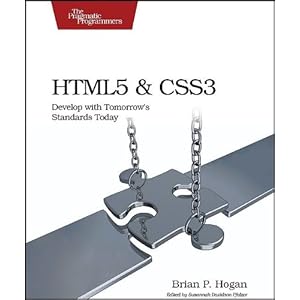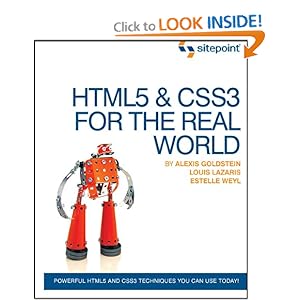Everyone is talking about HTML5 and CSS3. If you believe the hype, they will change how web development is done while feeding the world and creating new opportunities for people everywhere to enjoy a new era of peace, love, and rainbow-emitting unicorns. Obviously, I’ve been around long enough to be a skeptic.
That said, I do want to keep up on standards and trends, if only to keep my work from causing me embarrassment and to prevent having to do more work than necessary (by having to perform updates soon after code is written). With this in mind, I picked up two books on HTML5 and CSS3.
First, I read Pragmatic Programmer’s HTML5 and CSS3: Develop with Tomorrow’s Standards Today by Brian P. Hogan.
I liked this book. It was easy to read and understand. I liked that the book avoids hype and marketing speak and sticks to a clear description of HTML5 as a platform and as a specification. The author respects his intended audience, presumably people who are currently involved in web design and development and who don’t need their hands held with very basic descriptions of JavaScript, jQuery, or basic HTML and CSS from past versions. This book focuses on the new features that are most likely to be useful and exciting to developers: new structural tags and attributes, improved methods for creating web forms, making better interfaces, improving accessibility, and, of course, eye and ear candy in the form of canvas and media embedding.
Next, I read Sitepoint’s HTML5 & CSS3 For The Real World by Alexis Goldstein, Louis Lazaris, and Estelle Weyl.
This book is also intended for people with experience using HTML and CSS. The basics are often assumed and not covered in great depth. This means that most of the book is dedicated to things the target audience does not already know. In addition, this book also avoids the hype and unicorns and focuses on specific aspects of HTML5 and CSS3 that will be most useful to real world developers. The book includes a real world style example that is used to introduce the similarities and differences in the new versions of HTML and CSS that will make it easy for people familiar with the technology to jump in and do something practical.
HTML5 & CSS3 For The Real World covers all the same basic material as HTML5 and CSS3: Develop with Tomorrow’s Standards Today, but with some very useful and appreciated additions. Here we have coverage of Modernizer, a JavaScript library that can test for individual HTML5 features in a browser rather than simply checking what browser is being used, WAI-ARIA for making websites accessible more easily, and the Microdata Specification that allows machine-readable data to be embedded in HTML documents. Cool stuff!
Bottom line: both books are good, but HTML5 & CSS3 For The Real World covers more features and does so using better examples. I’ll give it a 5/5 and rate HTML5 and CSS3: Develop with Tomorrow’s Standards Today a very close second at 4/5.
Disclosure: I was given my copy of each of these books by the publishers as review copies.

